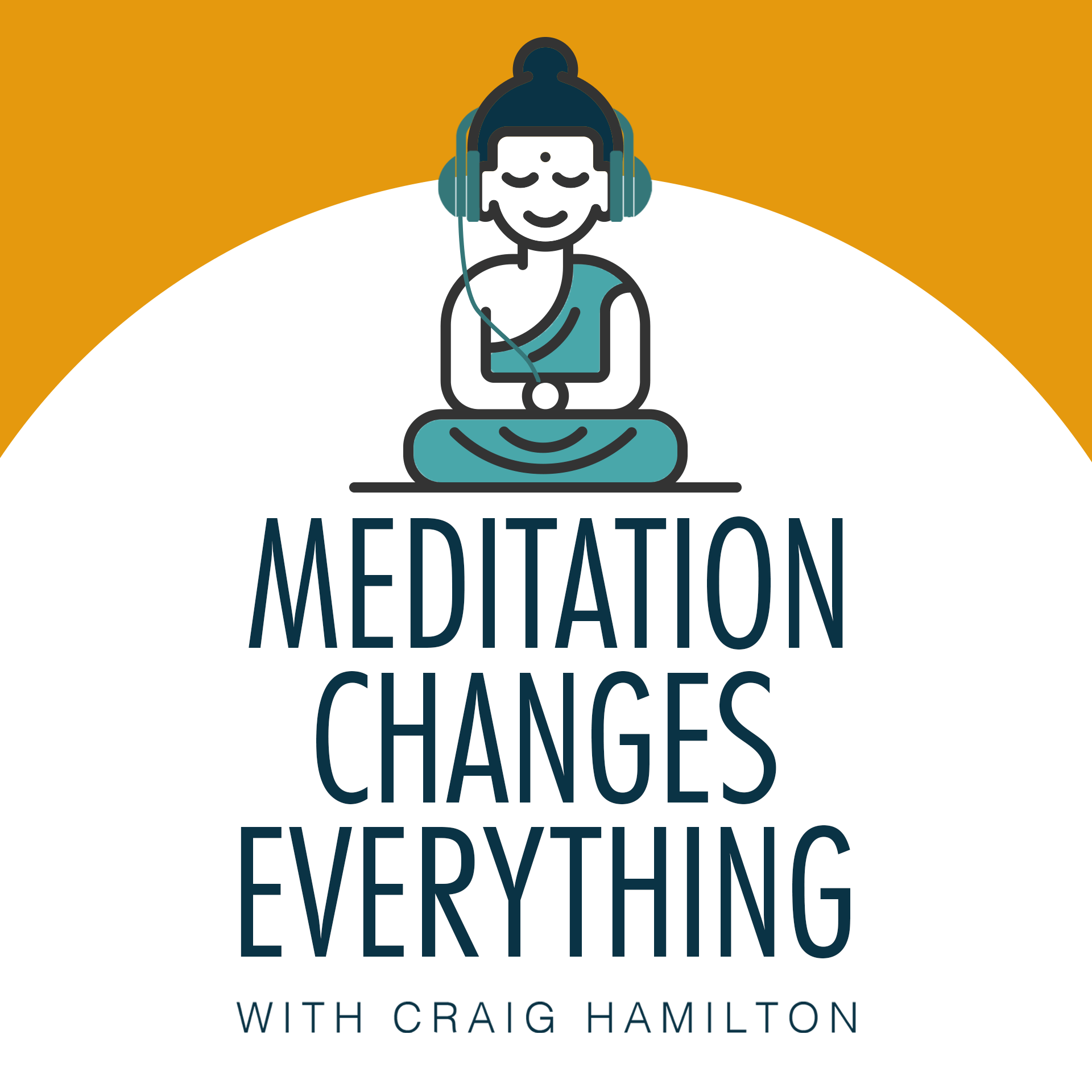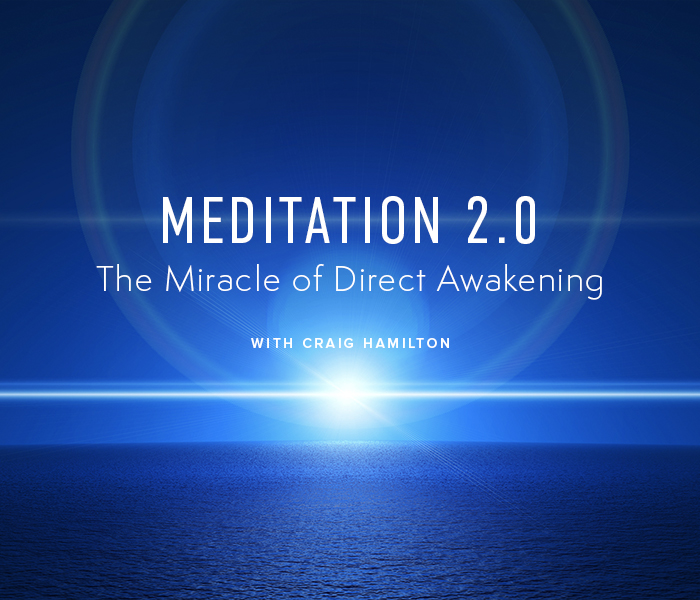In This Episode…
Meditation can lead us into some extraordinary states of consciousness—moments of stillness, spaciousness, or bliss that feel like a doorway has opened inside us. These states can be deeply nourishing, offering glimpses of something beyond the ordinary mind. But over time, even these expansive experiences can start to feel familiar. When meditation begins to drop us into the same place again and again, it’s worth asking: Are these states actually transforming us, or simply soothing us?
In this episode, Craig explores the difference between altered states and true awakening—and why confusing the two can quietly limit our growth. Through three focused segments, he examines how certain meditative states can subtly distract us from the deeper aim of practice, and how we can shift our orientation to stay more fully awake within each moment.
For a deeper experience of Craig’s approach to meditation, consider joining our Awakened Life membership program which offers in-depth guidance, a meditation workshop, and a live online retreat with Craig. Register today to receive your first month for 50% off at AwakenedLifeMembership.com.
If you’re interested in exploring more of Craig’s meditation experiments, you’re invited to tune in to a 90-minute online workshop Craig will be hosting called Meditation 2.0 – The Miracle of Direct Awakening. Register for free at FreeMeditationWorkshop.com.
If you would like to share your experience of the podcast or have questions about Craig’s teachings, please feel free to email us at support@craighamiltonglobal.com.
EPISODE TRANSCRIPT
Host: In our first segment, Craig looks at the pros and cons of the powerful state of concentration traditionally referred to as “Samadhi.”
Samadhi is the Sanskrit word for trance. In the Pali canon—the Buddhist canon—the word was samatha. A similar word, if you look at the spelling: samatha or samadhi.
These are the deep kinds of states the early yogis—who were doing very intense meditation—were trying to get into, because they felt the mind was an obstacle to awakening. They were trying to get beyond the mind. So they would go into these very deep states of consciousness: inner bliss, concentration, intense depth, inner peace, and tranquility. These states are very pleasant. They’re very still, quiet, and filled with a kind of pregnant silence and vibrational power.
In fact, they’re so filled with power that some of the early martial artists and warriors in East Asia would do these samadhi practices—these concentration practices—to try to gain more power to take into battle. They believed they could create samadhi power, harnessing the energies of the universe to become more powerful fighters.
Deep Samadhi States Are Not the Same as Spiritual Awakening
The power metaphor is not just a metaphor, at least in those traditions. It’s also what some of us have come to think of when we think of meditation: going into this totally deep, still, silent, powerful, present, tranquil place of potent, energized inner peace.
But those are samadhi states, and they’re not really the goal of the spiritual path—certainly not a path like this, which is about spiritual awakening to our true nature and enlightened essence. It’s been called our Buddha nature. This path is about gaining insight into the nature of reality, clear seeing into the miraculous essence that’s always present in every moment of being alive.
We’re not trying to go deep somewhere away from life or away from reality. We’re trying to go deep into the heart of reality—into what’s vibrating in every created thing and every moment—and to know that and be engaged in life from this luminous, expansive, profound, wise, loving consciousness. But these samadhi states, these intense trance states, can happen in any kind of meditation.
Stillness Is Not the Goal
A lot of the meditations we’re doing here are not designed to bring about samadhi states—except maybe when you’ve done some of the concentration practices, like following the breath, which I sometimes teach as a foundational practice. That’s a samadhi-type practice.
But over time, as the traditions got more subtle in their understanding of what awakening and enlightenment really are—and how meditation supports them—the conversation shifted. It became, “Well, we don’t want to go into samadhi too much. Maybe a little, but not too deep.” Because when we disappear into those deep trance states, there’s no ability to gain insight. When you’re that deeply still, and nothing is happening, and there’s no content—just silence in all directions—there’s no knowing. There’s no wisdom capacity. There’s no spark. And without that, there can’t be enlightenment. There can’t be illumination of your understanding, of your worldview, your personality, or your engagement. There’s no engagement—just depth and infinite stillness.
So the traditions stopped emphasizing samadhi practices. Or they would say, “We do that to gain some concentration, some foundational letting go of the world—but then we don’t stay there. We come back to the practices that lead to insight, wisdom, and enlightenment.” Stay with me. I hope you’re finding this useful—or at some point, you will.
The point is, this kind of state can occur at any point on the path, in any meditation. And for many of us, it can become a detour from the practice—and from the actual goal. So we want to be aware of that. Many of you have been around for a while, and you’ve heard me talk about this. Or you’ve asked questions, and I’ve spoken about it. We want to be aware that stillness is not the goal. Deep inner quietude, the absence of thought, the absence of content—that’s not where we’re trying to get to. But it can happen.
Samadhi States Aren’t a Problem Either
We don’t want to make it a negative thing, either. But we do want to stay with the practice, so we don’t just spiral down into the infinite depths of no mind and pure consciousness—and then just rest there, take up residence there, and discontinue the practice. Because here’s the thing: it can feel like the goal. It can certainly feel like a place to stop on the path. Especially if we don’t fully understand the path, or awakening, or what we’re really aiming for. It can feel so peaceful, so free from disturbance, so blissful and energizing and rich and nourishing—like we’re back in the womb. There’s a very seductive, alluring aspect to deep samadhi states.
This is something to be aware of. It’s not something to be afraid of. Let’s put it this way—there are a lot worse things that could be going on in your meditation than getting lost in deep samadhi or deep trance. You could be sitting there struggling endlessly just to quiet your mind. Or you could be lost in thought, processing the day’s events, planning for the future, and feeling emotionally disturbed. There are many things you could be doing in meditation that would be more problematic than slipping into a deep trance state.
The Goal Is Letting Go of the Mind…Entirely
But we’re practitioners. We’re serious, mature spiritual practitioners. We’re working to find the subtlety of discrimination and discernment—to separate the real from the unreal. To discover the subtle essence that is the essence of all things. It’s equally the essence of stillness as it is the essence of motion, of dynamism, of activity. It’s not found more in stillness than in action.
That’s what we’re trying to recognize—how to stay attuned to it, enlivened by it, immersed in it, awake to it. This mysterious, spiritual, diamond-like essence—sacred, luminous, vibrant consciousness that interpenetrates every single thing, without exception. And to be able to see that in everything.
The goal of the spiritual path is not to have no mind. It’s not to have no thought. And it’s not to negate all the wisdom and knowledge we’ve accumulated to help us navigate the world. The goal is to come to a place where we are no longer identified with the mind—where we’re no longer attached to knowing, to our certainties and stories. We’re no longer invested in what we know. We don’t really need to know. We’re discovering a way of living where we don’t need certainty in order to leap forward into each new moment, circumstance, situation, challenge, or opportunity.
Our heart is wide open. We’re an enthusiastic “yes,” regardless of how much we know or how certain we feel.
Perhaps there’s nothing we can do that has as radical an impact as the meditation practice of letting go of the mind entirely. There’s almost nothing more powerful for transforming our relationship to the mind than sitting still every day and having no involvement with thought—severing our identification with the mind. Because when we’re meditating, we don’t have to do anything. And that gives us a rare opportunity to simply let go of thought.
When Consciousness Becomes Aware of Consciousness
That’s hard to do during the day. It’s not impossible, but it’s an experiment—not a goal. But in meditation, we can do it. We can give it up. Let it go. It’s a very direct path to awakening. Because when consciousness is freed, even for a moment, from its fixation on the mind, it begins to know something else. It becomes aware of the mystery of its own nature. Consciousness becomes aware of consciousness. You become aware of something infinite—the infinite, miraculous depth of your own true being, beyond the mind.
Host: In our next segment, Craig responds to a question from a course participant that often arises for experienced meditators: If I keep slipping into the same deep, peaceful state every time I meditate, is that a sign of progress—or might I be getting stuck in a rut? Craig unpacks the difference between altered states and true awakening, and offers guidance on how to stay more fully conscious in practice, even when the experience feels good.
So, what I hear you saying is that even though the practices can differ a lot—like here, right now, we’re focusing on letting go of the mind, not giving attention to the mind, and then another practice might be to just let everything be as it is and embrace everything, or another might be to pay attention to consciousness itself—no matter what practice you do, your meditation is exactly the same?
Because from one point of view, the fact that you’re describing that, hey, whenever I meditate, I pretty much have an experience of some kind of depth, of deepening and opening, and it’s positive.
I get the sense that it’s a break from the ordinary for you, and you’re touching something. So something real is happening. And I can tell you, there are people here today listening to that and thinking, “Wow, I wish that happened every time I meditate.” Because a lot of times when I meditate, I’m just stuck in my head the whole time, and I feel anxious by the end. We all have different experiences.
Some of Us Easily Fall into Trance States
I want to say, there’s positive momentum in your practice. That’s good. And this, by the way, happens to a lot of meditators—particularly those who, let’s just say, easily access altered states of consciousness. Which, by the way, is just a typological thing in us human beings. It’s not necessarily a sign of being spiritually advanced, or the opposite if you can’t.
Some of us just have easy access to altered states. It’s like how some people are very easily hypnotized. You go to hypnotherapy, and boom—they’re under. Or you learn a meditation practice, and boom—you’re in an altered state. Some people are like that. Others don’t have that kind of access, but that doesn’t mean we can’t all receive the fruits of meditation. Because in this context, meditation isn’t really about altered states of consciousness.
So, for people who tend to have easy access to altered states, what often happens is they start to meditate, and there’s this groove in consciousness that’s already there—and they just slot into it. We just slip into it with whatever we’re doing. Because you’re saying, “Whether I’m doing this, or that, or the other”—these practices are very different from one another, but it doesn’t matter. Boom. I just flow into that place. And I’m somewhat conscious, but somewhat unconscious. It sounds like sometimes you don’t really know where you went—you just know you were in some deep place.
By the way, in the Indian tradition, these deep states are called Samadhi, which primarily refers to deep states of trance or absorption. You get so deeply absorbed that sometimes there’s no consciousness at all. You’re just deeply in the trance.
The Evolution of Trance States within the Traditions
A lot of early yogic and meditative traditions were about achieving these very deep states of trance and absorption. But then along came the Enlightenment teachings, which said, “Let’s not get too lost in these trance states.” Yes, they’re powerful, and they definitely touch into spiritual depth—but they don’t give us insight into the nature of reality. They don’t necessarily deconstruct the ego or awaken us to who we are beyond the mind. That’s a more profound insight process that requires enough consciousness and enough presence to access.
So most of the Enlightenment traditions started steering away from too much trance and more toward being very awake and present throughout the practice. The idea was to begin seeing in deeper and more subtle ways—What’s the ego? What’s the mind? What is consciousness? That’s the insight process. That’s awakening.
Staying Awake and Present Instead of Slipping into Samadhi
So for you, I’d say it sounds like you’re someone who can easily slip into this trance-like state. And it’s positive. It’s good. But the fact that it’s the same every time is a clear signal to me that it’s pulling you away from some of the more profound parts of the practice.
That’s why I said you have to hold this lightly and work with it. Don’t come in like a wrecking ball and try to demolish those states. It’s not like that.
What I’d invite you to do is bring more energy and attention to the part of the practice that’s about staying awake, present, and conscious. Don’t let yourself slip. Because if you really observe, you’ll notice—it feels good to go there. You kind of like it. It’s peaceful, it’s still, it’s tranquil, and it’s wooing you in. And you have to say, “No, not this time.”
It’s fine if it starts to happen, but don’t let yourself get swept away. Relate to that trance state, and to those subtle positive feelings, just like you would relate to thoughts. They’re alluring, they’re pulling you in, but instead, you stay with the practice. Don’t identify with it. Don’t go there. Don’t resist it either. But don’t preference it. Don’t let it carry you off.
See if you can stay with the practice—whatever it is that day, at that time. Really say to yourself, “No, I’m staying here. Yes, that feels really good—but no, I’m doing this practice.” Stay with that and see where it takes you.
Host: Throughout this episode, Craig has been exploring the difference between altered states and true awakening. In this last segment, he highlights how even the most peaceful states—like stillness or inner silence—can become distractions if we lose consciousness in them, rather than meeting them with awareness.
The Key Is To Stay Focused, Awake, and Present
Karen had a couple of questions she posted. In the first one, she says that when she follows these meditation prompts, she experiences “what I can only describe as nothing—a kind of spaciousness and darkness. It feels like I’ve really stepped away into an abyss, and it feels like an ineffable quality of awareness.” She’s wondering how that relates to Samadhi or trance, and whether it’s okay for that to be the result of the practice. She also asks, “Should I have more content present?”
I think this is a very relevant topic, and it’s something I spoke quite a bit about in the meditation workshop around Samadhi—specifically how conceptual stillness or nothingness isn’t the goal of spiritual practice or meditation. It’s more about inner freedom in the face of whatever arises, rather than a cessation of content. We’re not looking for thought to cease. We’re looking to experience freedom regardless of whether thoughts are coming and going. Freedom from the mind—not freedom from having a mind.
The point is, it’s not that any particular experience is good or bad or a problem. But we want to recognize that this experience of nothingness—or of falling into that kind of stillness—is not something to aim toward, cling to, or try to maintain. It’s more like any other phenomenon. You want to relate to it with neutrality and let it come and go.
But I think the key here is to really stay focused, awake, and present. Because falling into trance or Samadhi tends to involve losing consciousness a little. We drift out of awareness and into a deep, still, non-conceptual trance state.
Don’t Fall Asleep. Stay Awake and Aware.
Think of it as being similar to falling asleep. It’s not exactly sleep, but it’s like a deep trance—maybe you could say it’s a kind of deep Samadhi that resembles sleep. So you don’t want to fall into that and just disappear. You want to stay a conscious, active, present agent within the experience.
And if that kind of state is occurring in your meditation, that’s fine. Let it be there. But also make sure that you are still here—conscious, awake, and aware.
My sense is that if you stay present in that way, the experience will probably come and go. It’ll arise sometimes, and at other times it won’t. You won’t be clinging to it or fixated on it, and so it’ll just become part of the ebb and flow of experience.

NEWSLETTER
Follow The Podcast
Subscribe to Craig’s weekly Awakened Life Newsletter to receive his latest inspirational teachings and guided meditations.







